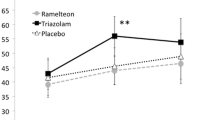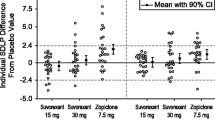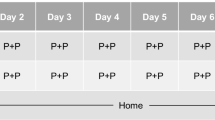Abstract
Rationale
Most studies that investigated the next-day residual effects of hypnotic drugs on daytime driving performances were performed on healthy subjects and after a single drug administration.
Objectives
In the present study, we further examine whether the results of these studies could be generalised to insomniac patients and after repeated drug administration.
Method
Single and repeated (7 day) doses of zolpidem (10 mg), zopiclone (7.5 mg), lormetazepam (1 mg) or placebo were administered at bedtime in a crossover design to 23 patients (9 men and 14 women aged 38.8±2.0 years) with Diagnostic and Statistical Manual of Mental Disorders, Fourth Edition (DSM-IV) primary insomnia. Driving tests were performed 9–11 h post-dose.
Results
Results showed that treatment effects were evidenced for subjective sleep, for driving abilities, and for electroencephalogram (EEG) recorded before (resting EEG) and during the driving simulation test (driving EEG). Compared to placebo, zopiclone increased the number of collisions and lormetazepam increased deviation from speed limit and deviation from absolute speed, whereas zolpidem did not differentiate from placebo on these analyses. EEG recordings showed that in contrast to zolpidem, lormetazepam and zopiclone induced typical benzodiazepine-like alterations, suggesting that next-day poor driving performance could relate to a prolonged central nervous system effect of these two hypnotics.
Conclusion
The present results corroborate studies on healthy volunteers showing that residual effects of hypnotics increase with their half-lives. The results further suggest that drugs preserving physiological EEG rhythms before and during the driving simulation test 9–11 h post-dose, such as zolpidem, do not influence next-day driving abilities.

Similar content being viewed by others
References
American Psychiatric Association (1994) Diagnostic and statistical manual of mental disorders, 4th edn. APA, Washington, DC
Barbone F, McMahon AD, Davey PG, Morris AD, Ried IC, McDevitt DG et al (1998) Association of road-traffic accidents with benzodiazepine use. Lancet 352:1331–1336
Bauer G (1993) EEG, drug effects and central nervous system poisoning. In: Niedermeyer E, Lopes da Silva S (eds) Electroencephalography. Basic principles, clinical applications, and related fields, 3rd edn. Williams & Wilkins, Baltimore, pp 631–642
Bixler EO, Kales A, Soldatos CR, Kales JD, Healey S (1979) Prevalence of sleep disorders in the Los Angeles metropolitan area. Am J Psychiatry 136:1257–1262
Bocca M, Le Doze F, Etard O, Pottier M, L'Hoste J, Denise P (1999) Residual effect of zolpidem 10 mg and zopiclone 7.5 mg versus flunitrazepam 1 mg and placebo on driving performance and ocular saccades. Psychopharmacology 143:373–379
Bonnet MH, Arand DL (1997) Hyperarousal and insomnia. Sleep Med Rev 1:97–108
Brookhuis KA, Volkerts ER, O'Hanlon JF (1990) Repeated dose effects of lormetazepam and flurazepam upon driving performance. Eur J Clin Pharmacol 39:83–87
Coenen AML, van Luijtelaar EJM (1991) Pharmacological dissociation of EEG and behaviour: a basic problem in sleep–wake classification. Sleep 14:464–465
Davies M, Newell JG, Derry JMC, Martin IL, Dunn SMJ (2000) Characterization of the interaction of zopiclone with γ-aminobutyric acid type A receptor. Mol Pharmacol 58:756–762
de Visser SJ, van der Post JP, de Waal PP, Cornet F, Cohen AF, van Gerven JM (2003) Biomarkers for the effects of benzodiazepines in healthy volunteers. Br J Clin Pharmacol 55:39–50
Dupuy HJ, Engel A, Devine BK, Scanlon J, Querec L (1970) Selected symptoms of psychological distress. US Vital Health Stat 1 11:1–44
Freeman HL (1996) Is there a need for a para hypnotic? Approaches to the co-diagnosis of insomnia and anxiety. J Drug Dev Clin Pract 7:289–302
Gold MS, Miller NS, Stennie K, Populla-Vardi C (1995) Epidemiology of benzodiazepine use and dependence. Psychiatr Ann 25:146–148
Hemmelgarn B, Suissa S, Huang A, Boivin JF, Pinard G (1997) Benzodiazepine use and the risk of motor vehicle crash in the elderly. JAMA 278:27–31
Iudice A, Bonanni E, Maestri M, Nucciarone B, Brotini S, Manca L, Iudice G, Murri L (2002) Lormetazepam effects on daytime vigilance, psychomotor performance and simulated driving in young adult healthy volunteers Int J Clin Pharmacol Ther 40:304–309
Johnson LC, Spinweber CL (1983) Good and poor sleepers differ in Navy performance. Mil Med 148:727–731
Karle J, Nielsen M (1998) The mechanism of action and pharmacology of zopiclone. Rev Contemp Pharmacother 9:77–87
Kecklund G, Akerstedt T (1993) Sleepiness in long distance truck driving: an ambulatory EEG study of night driving. Ergonomics 36(9):1007–1017
Lal SK, Craig A (2002) Driver fatigue: electroencephalography and psychological assessment. Psychophysiology 39(3):313–321
Meerlo P, Westerveld P, Turek FW, Koehl M (2004) Effects of gamma-hydroxybutyrate (GHB) on vigilance state and EEG in mice. Sleep 27:899–904
Mellinger GD, Balter MB, Uhlenhuth EH (1985) Insomnia and its treatment. Prevalence and correlates. Arch Gen Psychiatry 42:225–232
Neutel I (1998) Benzodiazepine-related traffic accidents in young and elderly drivers. Hum Psychopharmacol Clin Exp 13:S115–S123
Nowell PD, Mazumdar S, Buysse DJ, Dew MA, Reynolds CF III, Kupfer DJ (1997) Benzodiazepines and zolpidem for chronic insomnia: a meta-analysis of treatment efficacy. JAMA 278:2170–2177
Ohayon M (1996) Epidemiological study on insomnia in the general population. Sleep 19(3 Suppl):S7–S15
Ohayon M (2002) Epidemiology of insomnia: what we know and what we still need to learn. Sleep Med Rev 6:97–111
Parrott AC, Hindmarch I (1980) The Leeds Sleep Evaluation Questionnaire in psychopharmacological investigations—a review. Psychopharmacology (Berl) 71(2):173–179
Regestein QR, Dambrosia J, Hallett M, Murawski B, Paine M (1993) Daytime alertness in patients with primary insomnia. Am J Psychiatry 150:1529–1534
Risser MR, Ware JC, Freeman FG (2000) Driving simulation with EEG monitoring in normal and obstructive sleep apnea patients. Sleep 23(3):393–398
Sanger DJ, Depoortere H (1998) The pharmacology and mechanism of action of zolpidem. CNS Drugs Rev 4:323–340
Schier MA (2000) Changes in EEG alpha power during simulated driving: a demonstration. Int J Psychophysiol 37(2):155–162
Schneider-Helmert D (1987) Twenty-four-hour sleep–wake function and personality patterns in chronic insomniacs and healthy controls. Sleep 10:452–462
Schreckenberger M, Lange-Asschenfeld C, Lochmann M, Mann K, Siessmeier T, Buchholz HG, Bartenstein P, Gründer G (2004) The thalamus as the generator and modulator of the alpha rhythm: a combined PET/EEG study with lorazepam challenge in humans. NeuroImage 22:637–644
Staner L, Cornette F, Maurice D, Viardot G, Le Bon O, Haba J, Staner C, Luthringer R, Muzet A, Macher JP (2003) Sleep microstructure around sleep onset differentiates major depressive insomnia from primary insomnia. J Sleep Res 12:319–330
Stepanski E, Zorick F, Roehrs T, Young D, Roth T (1988) Daytime alertness in patients with chronic insomnia compared with asymptomatic control subjects. Sleep 11:54–60
Torsvall L, Akerstedt T (1987) Sleepiness on the job: continuously measured EEG changes in train drivers. Electroencephalogr Clin Neurophysiol 66:502–511
Van Laar MW, Volkerts ER (1998) Driving and benzodiazepine use; evidence that they do not mix. CNS Drugs 10:383–396
Vermeeren A (2004) Residual effects of hypnotics. Epidemiology and clinical implications. CNS Drugs 18:297–328
Vermeeren A, O'Hanlon JF, Declerck AC (1995) Acute effects of zolpidem and flunitrazepam on sleep, memory and driving performance, compared to those of partial sleep deprivation and placebo. Acta Ther 21:47–64
Vermeeren A, Danjou PE, O'Hanlon JF (1998) Residual effects of evening and middle of the night administration of zaleplon 10 and 20 mg on memory and actual driving performance. Hum Psychopharmacol Clin Exp 13:S98–S107
Vermeeren A, Riedel WJ, van Boxtel MP, Darwish M, Paty I, Patat A (2002) Differential residual effects of zaleplon and zopiclone on actual driving: a comparison with a low dose of alcohol. Sleep 25:224–231
Verster JC, Volkerts ER, Verbaten MN (2002) Effects of alprazolam on driving ability, memory functioning and psychomotor performance: a randomized, placebo-controlled study. Neuropsychopharmacology 27:260–269
Verster JC, Veldhuizen DS, Volkerts ER (2004) Residual effects of sleep medication on driving ability. Sleep Med Rev 8:309–325
Volkerts ER, O'Hanlon EF (1988) Residual effects on real car driving performance. Zopiclone versus flunitrazepam and nitrazepam. J Drug Ther Res 13:111–114
Volkerts ER, Louwerens JW, Gloerich ABM (1984) Zopiclone's residual effect upon actual driving performance versus those of nitrazepam and flunitrazepam. VSC, Report 84-10, Traffic Research Centre, Groningen, The Netherlands
Volkerts ER, Van Laar MW, Van Willigenburg AP, Plomp TA, Maas RAA (1992) A comparative study of on-the-road and simulated driving performance after nocturnal treatment with lormetazepam 1 mg and oxazepam 50 mg. Hum Psychopharmacol 7:297–309
Wheatley D, Balter M, Levine J, Lipman R, Bauer ML, Bonato R (1975) Psychiatric aspects of hypertension. Br J Psychiatry 127:327–336
Wikler A (1952) Pharmacological dissociation of behaviour and EEG sleep patterns in dogs: morphine, N-allylnormorphine and atropine. Proc Soc Exp Biol Med 79:261–265
Acknowledgements
This study was supported by the Sanofi-Aventis Group, manufacturer of zolpidem and zopiclone.
Author information
Authors and Affiliations
Corresponding author
Rights and permissions
About this article
Cite this article
Staner, L., Ertlé, S., Boeijinga, P. et al. Next-day residual effects of hypnotics in DSM-IV primary insomnia: a driving simulator study with simultaneous electroencephalogram monitoring. Psychopharmacology 181, 790–798 (2005). https://doi.org/10.1007/s00213-005-0082-8
Received:
Accepted:
Published:
Issue Date:
DOI: https://doi.org/10.1007/s00213-005-0082-8




